Data and AI Training
Home | Prices | Contact Us | Courses: Power BI - Excel - Python - SQL - Generative AI - Visualising Data - Analysing Data
An introduction to SQL
This article will introduce SQL , the language for retrieving (querying) data from a database and teach how to craft simple SQL statements to retrieve data then do some calculations and summaries. The presenter will demo the tools and editors to write and execute the SQL, and touch upon how generative AI assistants are helping us to write SQL. The session aims to give you confidence to start using SQL in your day to day roles.
SQL stands for Structured (English) Query Language.
We start with why it is useful to learn SQL (at least conceptually).
SQL is the key to unlocking the world’s valuable data
We think of SQL in relation to relational databases, for example, Microsoft’s SQL Server and lots of other databases: Oracle, IBM’s DB2, Postgres, Maria, BiqQuery, Snowflake, MySQL and others. But SQL is also used to retrieve for data lakes e.g. lots of large CSV files, via with a “SQL end-point”. SQL is also used to read data from large data warehouses e.g. the SparkSQL language is based on SQL.
Here is the list of data sources that DBeaver, a popular SQL tool, can connect to.
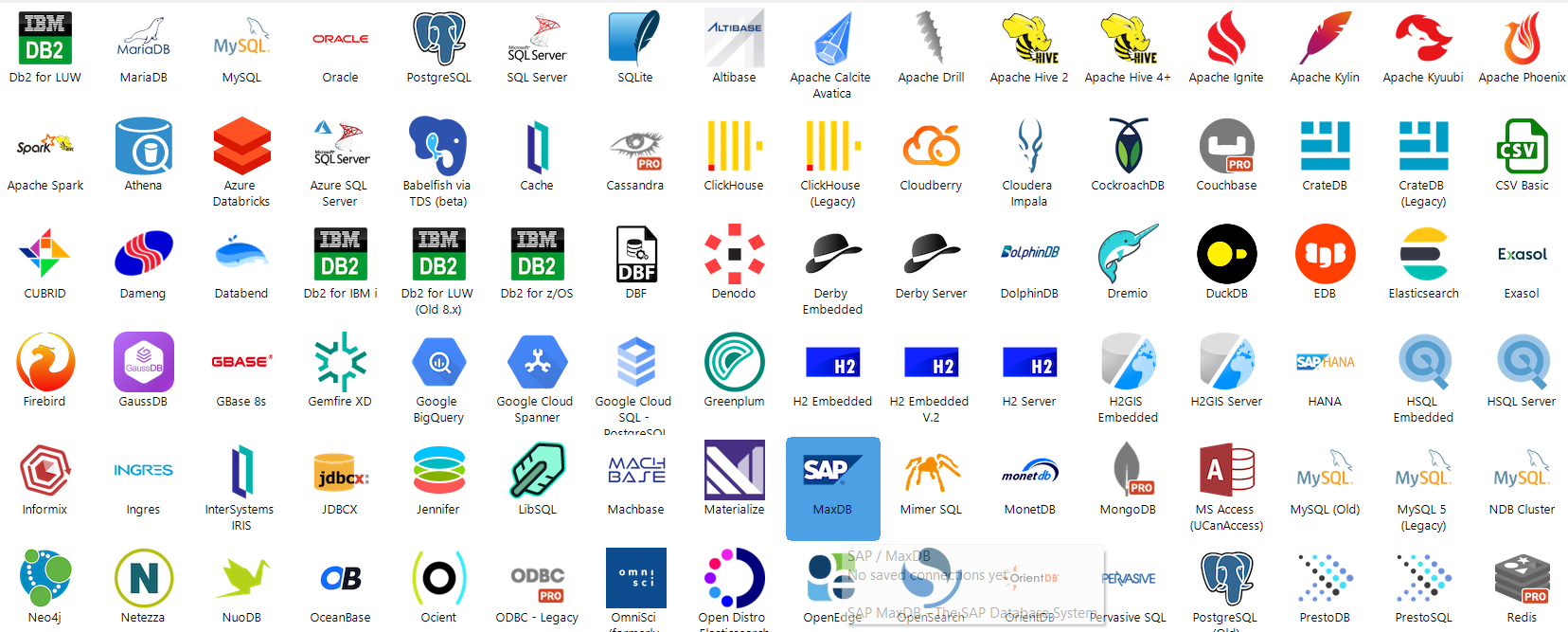

Sample Data
The data that we are going to use in our examples is in two tables. The fictitious PatientStay table lists patient stays in a few hospitals in London. Here are a few rows of that table
| PatientId | AdmittedDate | DischargeDate | Hospital | Ward | Tariff | Ethnicity |
|---|---|---|---|---|---|---|
| 1 | 2024-02-27 | 2024-03-06 | Kingston | Dermatology | 2.4 | White |
| 2 | 2024-02-27 | 2024-03-04 | Kingston | Ophthalmology | 8.2 | Black British |
| 3 | 2024-02-27 | 2024-03-08 | PRUH | Day Surgery | 4.7 | Asian |
| 4 | 2024-02-27 | 2024-02-29 | Oxleas | Dermatology | 8.3 | |
| 5 | 2024-02-27 | 2024-03-02 | Oxleas | Ophthalmology | 5.1 | White |
The DimHospital table lists hospitals in London.
| Hospital | HospitalType | HospitalSize | Reach |
|---|---|---|---|
| Kings College | Teaching | Medium | City |
| Kingston | General | Small | County |
| Oxleas | General | Medium | County |
| PRUH | Teaching | Small | County |
Notice that both tables have a column named Hospital and that these columns have the same set (domain) of values e.g. Kingston and PRUH. In the DimHospital table, the values of the Hospital column are unique - each row has a different value in this column.
SQL experts will complain (correctly) that I have used a business key as a primary key. I should have created a surrogate key.
Here is the structure of these two tables.
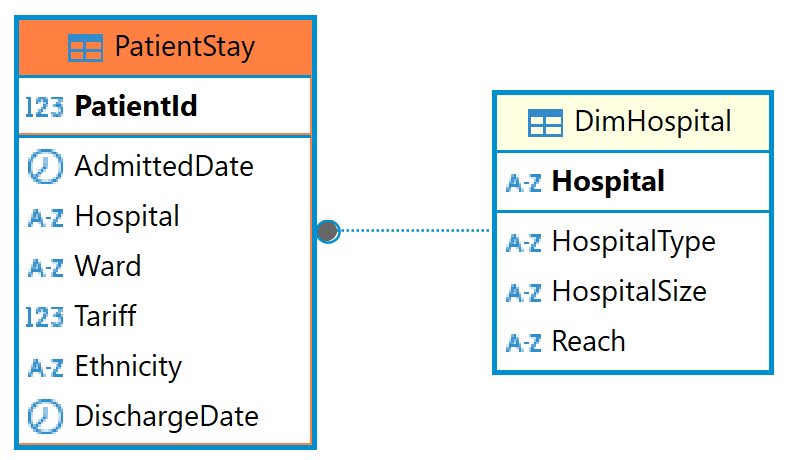
The PatientID column in PatientStay and the Hospital column in DimHospital are in bold because they are the primary keys. The database will not allow duplicate or missing (NULL) values in these columns.
The icons to the left of the column names indicate the datatype of the column: these include number (int and float), date or text (varchar).
The line between the Hospital columns that show these two table have a relationship. The Hospital column in PatientStay is a foreign key that references the Hospital column, the primary key, in DimHospital. This ensures that there will never be a patient in a hospital that is not in the DimHospital table.
A good database administrator (DBA) will include primary and foreign keys in their database design. Check if they exist on your data.
Here is the database map (known as an entity relationship diagram) of a small but canonical database. The lines between the tables indicate that the DBA has set up primary and foreign key relationships between the tables.
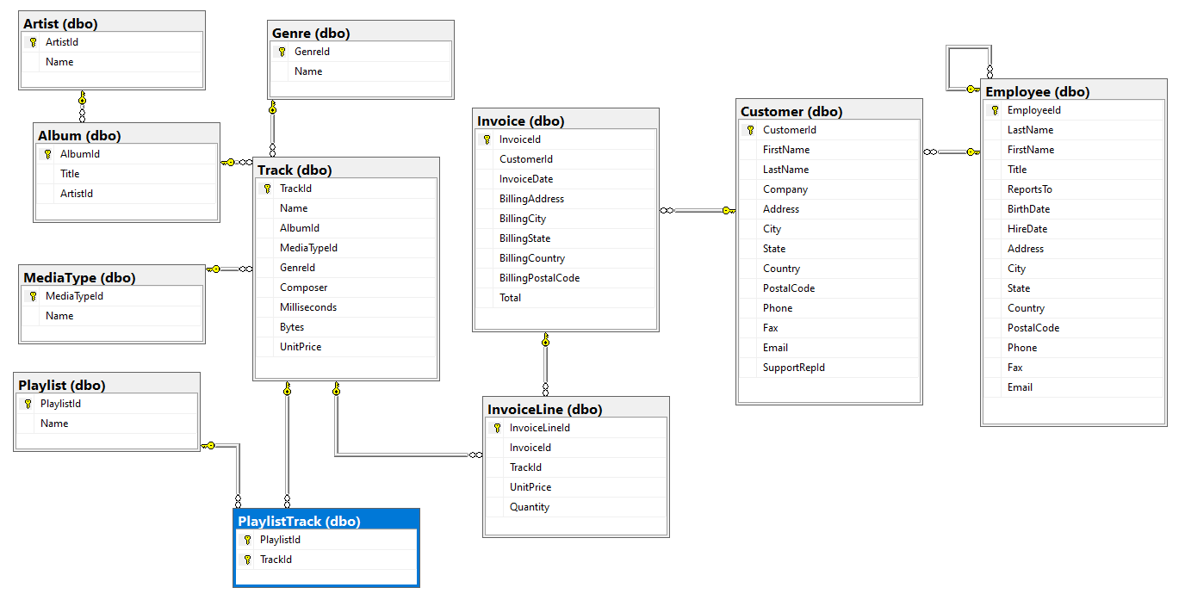
SQL and Database 101
SQL goes hand in glove with the de-facto pattern of organising data:
- Data is stored in a table - an arrangement of data with rows and columns. No data can exist in a database outside of a table.
- A database is a collection of tables.
- These tables may be related - two tables may have each have a column with values from the same domain. For example, an Invoice table and a Customer table may both have a column named CustomerId.
The database builder can constrain the data in the database, e.g., column datatypes, primary and foreign keys (which provide referential integrity), check constraints. Used properly, these contribute to enforcing good data quality.
For completeness, relational databases also contain:
- some parcels of SQL code to organise and manage the tasks we want the database to perform, e.g., views, stored procedures and functions.
- some structures to improve the performance of the database e.g., indexes make retrieval quicker
We won’t talk about these today - perhaps in the next talk.
You are going to use SQL in your career
SQL was invented in the early 1970s. That’s a long time ago! In 1970
- the Beatles broke up
- Apollo 13 had a problem
- Brazil, led by Pele, won the World Cup
SQL become an ANSI standard in 1986 - this was a big deal. SQL now had formal rules which has led to widespread adoption (but the AI in ANSI stands for ?).
SQL became an ISO standard in 1989 (and the I in ISO stands for ?).
I could have given exactly this talk 10 years ago (and will probably give it again in 10 years time!)
It is not usual for computer languages to have such a long lifespan
- some have gone e.g. COBOL, FORTRAN
- some have come e.g. Python, invented in 1989
- some have come and gone e.g. Pascal, ALGOL, Ruby, LISP, OPS5,…
Why you will like SQL
SQL has many advantages, for example,
- English-like
- easy to learn, especially the basics
- but also efficient, elegant and powerful
- declarative: that means you don’t need to write a complex algorithm, you just need to ask a question
- ANSI and ISO standard – you learn it once and use it across all database systems
- commercially important. It is the key that unlocks much of of the world’s important data.
The best thing about SQL - you can stop relying on IT (and waiting for them) to generate those reports you need now!
You can automate tasks with SQL - reduce manual procedures.
Finally SQL skills are valued - SQL looks good on your CV.
The SQL SELECT statement
If we only need to know how use SQL to get data, all we need is the SELECT statement. The syntax is as follows.
SELECT
<column>
, <column>
, <column>
…
FROM
<table>
WHERE
<where-clause>
ORDER BY
<column>
, <column>;
Here is the simplest SQL statement and the first few rows of the data it returns. Note that we can write comments to explain why we are doing something. Single line comments start with a – and multi-line comments are surrounded with a /* and */.
-- The asterisk (pronounced 'star') means bring back all columns of the table
SELECT
*
FROM dbo.PatientStay;
| Patient ID | AdmittedDate | Hospital | Ward | Tariff | Ethnicity | DischargeDate |
|---|---|---|---|---|---|---|
| 1 | 2024-02-26 | Kingston | Dermatology | 2.2 | White | 2024-03-04 |
| 2 | 2024-02-26 | Kingston | Ophthalmology | 8.3 | Black British | 2024-02-27 |
| 3 | 2024-02-26 | PRUH | Day Surgery | 4.7 | Asian | 2024-02-28 |
Here is a more complex SQL statement and the data it returns.
- the specific columns are listed in the column list
- this includes a calculated column (LengthOfStay)
- the data is filtered by several criteria
- there is a multi-column sort
SELECT
ps.PatientId
, ps.AdmittedDate
, ps.DischargeDate
, ps.Hospital
, ps.Ward
, DATEDIFF(DAY, ps.AdmittedDate, ps.DischargeDate) + 1 AS LengthOfStay
FROM
PatientStay ps
WHERE
ps.Hospital IN ( 'Oxleas', 'PRUH' )
AND ps.AdmittedDate BETWEEN '2024-02-01' AND '2024-02-29'
AND ps.Ward LIKE '%Surgery'
ORDER BY
ps.AdmittedDate DESC
, ps.PatientId DESC;
| Patient ID | AdmittedDate | DischargeDate | Hospital | Ward | LengthOfStay |
|---|---|---|---|---|---|
| 150 | 2024-02-27 | 2024-03-06 | Oxleas | Day Surgery | 9 |
| 130 | 2024-02-27 | 2024-03-05 | Oxleas | General Surgery | 8 |
| 6 | 2024-02-26 | 2024-02-28 | Oxleas | Day Surgery | 3 |
| 3 | 2024-02-26 | 2024-02-28 | PRUH | Day Surgery | 3 |
A SQL SELECT statement with a GROUP BY and aggregate functions
A GROUP BY clause summarises data at a higher level. Here is the syntax.
SELECT <column>
, <column>
, AGG(<column>)
…
FROM <table>
WHERE <where-clause>
GROUP BY <column>, <column>
HAVING <having-clause>
ORDER BY <column>, <column>;
The SQL statement below does the following.
- group the patients by hospital
- for each group, aggregate the values:
- count the number of patients admitted (and call this the NumberOfAdmissions) and
- sum up the total tariff (and call this the TotalTariff).
- the HAVING clause filters the data after the aggregation to return only hospitals with more than 10 patients
- the result is sorted so that the hospital with the most admissions is at the top
SELECT
ps.Hospital
, COUNT(*) AS NumberOfAdmissions
, SUM(ps.Tariff) AS TotalTariff
FROM
PatientStay ps
GROUP BY
ps.Hospital
HAVING
COUNT(*) > 10
ORDER BY
NumberOfAdmissions DESC;
This is the result.
| Hospital | NumberOfAdmissions | TotalTariff |
|---|---|---|
| Oxleas | 15 | 96.1 |
| Kings College | 13 | 83.2 |
| Kingston | 12 | 70.9 |
That’s all we need to learn (for a single table)
We need only 5 operations on tabular data
- Project (choose the columns)
- Mutate (create a new column with calculated values)
- Filter (choose the rows) with the WHERE clause
- Group by / aggregate (summarise) with the GROUP BY clause
- Sort (put the rows in a certain order) with the ORDER BY clause
Retrieve data across two tables into a single resultset with JOIN
SELECT
ps.PatientId
, ps.AdmittedDate
, h.HospitalType
, h.HospitalSize
FROM
PatientStay ps
JOIN DimHospital h ON
ps.Hospital = h.Hospital;
This SQL statement returns data that contains columns from both tables.
| Patient ID | Admitted Date | Hospital Type | Hospital Size |
|---|---|---|---|
| 1 | 2024-02-26 | General | Small |
| 2 | 2024-02-26 | General | Small |
| 3 | 2024-02-26 | Teaching | Small |
| 4 | 2024-02-26 | General | Medium |
SQL editors
We need a SQL editor to write and run SQL. Examples are:
- VSCode with the mssql extension. This is lightweight, modern, and highly recommended.
- SQL Server management Studio (SSMS), shown below: traditional, heavy, popular, only Microsoft SQL Server
- DBeaver, has community edition, helpful, most popular databases
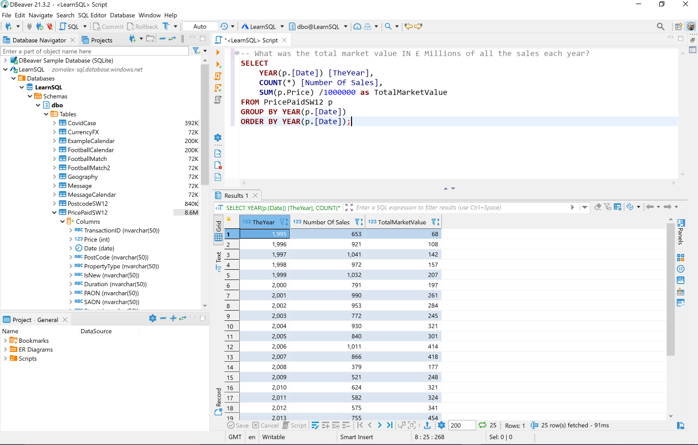
Some hints for writing SQL without tears
- Write a SQL statement in baby steps!
- Start with
SELECT ps.* FROM PatientStay ps; - Use the autocomplete. It is very helpful.
- Start from something that works, not something that doesn’t.
- Read the error messages – they are sometimes useful.
- Look at where the red squiggerly line starts.
Use AI to solve SQL challenges
AI is a useful, practical, everyday tool, that we can use now to help us write SQL and learn SQL.
Generative AI large language models (LLMs) such as ChatGPT, Copilot, Claude, Gemini have free editions and are available from a browser.
Pair programmers help us write better SQL from inside the SQL editor e.g. GitHub Copilot inside VSCode editor
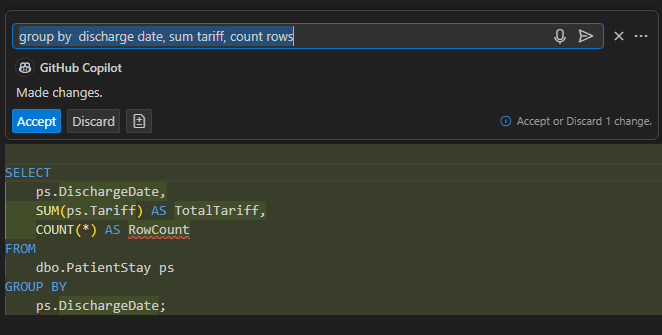
Generative AI example
Write the SQL query based on the English language instruction.
Table PatientStay contains details about patient stays in hospital.
The columns are PatientId, AdmittedDate, DischargeDate, Hospital, Ward, Tariff and Ethnicity.
PatientId is the Primary Key, It is a whole number and must be unique.
AdmittedDate and DischargeDate are dates.
Hospital, Ward and Ethnicity are text fields, with a maximum length of 50 characters.
Tariff is a floating point number and represent the costs associated with that patient's stay in hospital.
All columns are mandatory, apart from DischargeDate and Ethnicity.
Here is an example prompt and response.
<example-prompt>
List patients admitted in February 2024 to a surgical ward (one ending with 'Surgery') in either the Oxleas or PRUH hospitals.
Show these details: patient id, admitted date, discharge date, hospital, ward.
Add another column LengthOfStay.
Sort by admitted date (latest first) then by Patient Id (highest first).
<example-prompt>
<example-response>
SELECT
ps.PatientId
, ps.AdmittedDate
, ps.DischargeDate
, ps.Hospital
, ps.Ward
, DATEDIFF(DAY, ps.AdmittedDate, ps.DischargeDate) AS LengthOfStay
FROM
PatientStay ps
WHERE
ps.Hospital IN ( 'Oxleas', 'PRUH' )
AND ps.AdmittedDate BETWEEN '2024-02-01' AND '2024-02-29'
AND ps.Ward LIKE '%Surgery'
ORDER BY
ps.AdmittedDate DESC
, ps.PatientId DESC;
</example-response>
Next steps in your SQL learning journey
The best way to learn is to practice. It’s best by far to practice your own data and SQL tools at work but if this is not possible, here are some alternatives
- The SQL section of the W3schools website has short concise reference section, a good tutorial and a browser window where you can write and test SQL SELECT statements against a small table.
- You can install SSMS (for Microsoft SQL Server) or DBeaver Community Edition (for most databases). Both are free.
- A modern alternative is to use VSCode with the mssql extension, either locally or with GitHub Codespaces. Full details here.
We also offer training courses in SQL - details here.
SQL database builders and data engineers have an interesting job
There are other helpful things that people who actually build databases need to consider (but we don’t). SQL can do all of this:
- create databases, and make them fast, secure, highly available
- create primary and foreign keys to maintain data quality and consistency
- create indexes to make retrieval faster
- create the objects in a database: tables, views, stored procedures, functions
- add and edit data in the the database (with the INSERT, UPDATE and DELETE statements)